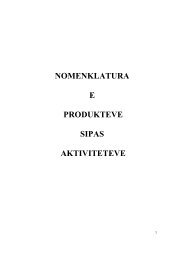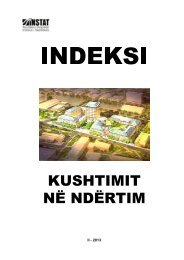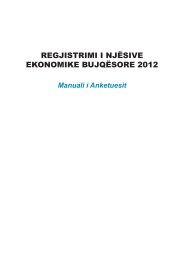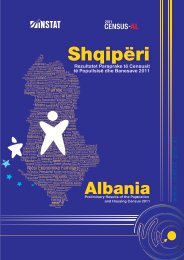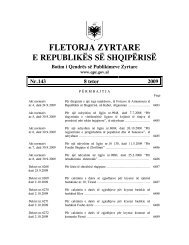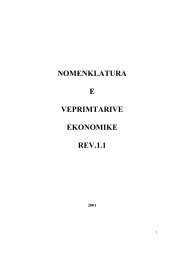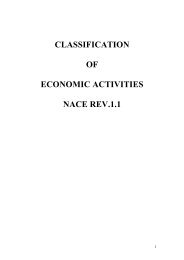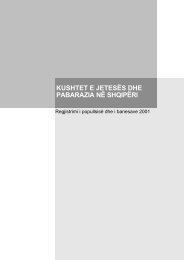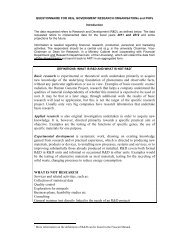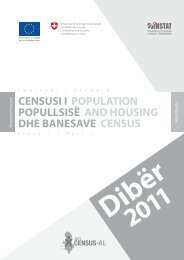Description of methods and sources for Albania - INSTAT
Description of methods and sources for Albania - INSTAT
Description of methods and sources for Albania - INSTAT
- No tags were found...
You also want an ePaper? Increase the reach of your titles
YUMPU automatically turns print PDFs into web optimized ePapers that Google loves.
IPA 2009 Multi-beneficiary StatisticalCooperation ProgrammeGDP data by industrial activity (25 activities) is compiled by using the EuropeanClassification <strong>of</strong> Economic Activities (NACE Rev 1) <strong>of</strong> Eurostat. The NACE classificationused in <strong>Albania</strong> is the same as the original version <strong>of</strong> NACE classification <strong>of</strong> Eurostat.However the economic activities according the NACE REV 1 are regrouped in the level <strong>of</strong>25 main activities <strong>for</strong> the needs <strong>of</strong> NAD. Table 1.1 presents the way how NACE 4 digitlevel is grouped at the level <strong>of</strong> 25 economic activities.For the dissemination purposes, those 25 activities are regrouped into 7 major industrialactivities:1. Agriculture, Hunting <strong>and</strong> Forestry2. Total Industry• Extracting Industry• Manufacturing Industry3. Construction4. Trade, Hotels <strong>and</strong> Restaurants,5. Transport6. Post <strong>and</strong> Communications7. Other Services.The level <strong>of</strong> synthetic economic activities, known as level 25 or level 7, is a combination <strong>of</strong>classes <strong>and</strong> NACE groups, organized to reveal representative sets in the context <strong>of</strong> theeconomic analysis. Thus the activities <strong>of</strong> manufacturing industry are regrouped in order toeasily identify intermediate industries <strong>of</strong> goods, capital goods industries, <strong>and</strong> industries <strong>of</strong>consumer goods. This nomenclature is articulated well with those used in the analysis <strong>of</strong>the economic situation. (See the Table 1.1)Nomenclatures used in the expenditure approachThe classification <strong>of</strong> Individual Consumption (COICOP) <strong>and</strong> the classification <strong>of</strong> theFunctions <strong>of</strong> Government (COFOG) have been used in the national accounts. ThePRODCOM is not used <strong>for</strong> the PPI; actually Classification <strong>of</strong> Products by Activity (CPA)is used. The nomenclatures used <strong>for</strong> the exports <strong>and</strong> imports <strong>of</strong> goods are: the HarmonizedCommodity <strong>Description</strong> <strong>and</strong> Coding System (HS) <strong>and</strong> St<strong>and</strong>ard International TradeClassification (SITC).The Harmonized Commodity <strong>Description</strong> <strong>and</strong> the Coding System(Harmonized System, or HS) or extended versions based on HS, such as the CombinedNomenclature used by our country provide such details. Classification using thesenomenclatures is based on the nature <strong>of</strong> the commodity.Commodity categories that are more apt <strong>for</strong> economic analysis are provided by theSt<strong>and</strong>ard International Trade Classification (SITC), which classifies commoditiesaccording to their stage <strong>of</strong> production.15/236



